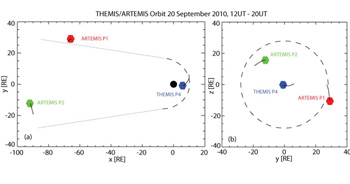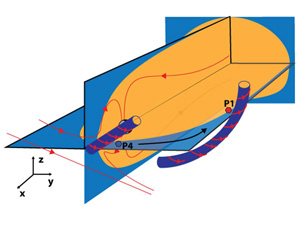2012 ARTEMIS SCIENCE NUGGETS
Survival of flux transfer event (FTE) flux ropes far along the tail magnetopause
by Dr. Jonathan P. Eastwood, The Blackett Laboratory
Imperial College London, London, UK
Introduction
The Earth's magnetic field extends into space where it forms a bubble around the Earth called the magnetosphere. The magnetosphere deflects the solar wind around the Earth, but occasionally the solar wind accesses the magnetosphere via the process of magnetic reconnection. When magnetic reconnection occurs, the solar wind magnetic field becomes connected to the magnetospheric magnetic field at an X-line on the subsolar magnetopause. This leads to the so-called "open magnetosphere" because the solar wind can directly enter the magnetosphere (see Figure 1).
| Figure 1.The concept of the open magnetosphere was first published in 1961 by J. W. Dungey. In the picture, the solar wind flows from the left, and reconnection at an X-line allows the solar wind to enter the open magnetosphere (Figure taken from Dungey, Phys. Rev. Lett., 6, 47, 1961) |
This basic picture implies that the transport of solar wind plasma into the magnetosphere is steady and smooth. However, experimental evidence and computer simulations suggest that even under relatively steady solar wind conditions magnetopause reconnection can be unsteady and time-dependent, leading to the formation of so-called flux transfer events (FTEs) which are, roughly speaking, lumps of reconnected material observed on the magnetopause.
Various formation mechanisms have been proposed based on patchy reconnection, bursty reconnection at a single elongated X-line and multiple X-line reconnection (see Figure 2). The vast majority of FTE observations have been made on the dayside magnetopause and so the evolution and fate of FTEs as they are transported into the magnetotail is poorly understood. Their fate and importance depends on how they form. If they form in the manner described by model #1 then their axes should rotate towards orientations parallel to the Sun-Earth line, and "sink" into the tail of the magnetosphere. However, if FTE formation is described by model #3, for example, they may become connected to the ionosphere at both ends, or open to the solar wind at both ends, in which case the term flux transfer event would be a misnomer, since in the latter case these structures would not, in themselves, transfer solar wind material into the magnetosphere. So it is important to understand how FTEs form, and what their ultimate fate is, to really understand how solar wind – magnetosphere coupling works.
| Figure 2. FTE formation mechanisms (left) FTE formation mechanism #1: patchy reconnection [Figure from Russell & Elphic, Space Sci. Rev., 22, 681, 1978] (middle) FTE formation mechanism #2: bursty reconnection [Figure from Southwood et al., Planet. Space Sci., 36, 503, 1988; Scholer, Geophys. Res. Lett., 15, 291, 1988] (right) FTE formation mechanism #3: multi-point reconnection [Figure from Lee and Fu, Geophys. Res. Lett., 12, 105, 1985]. Each mechanism produces a lump of reconnected material that travels along the magnetopause. However, it is very important to understand which mechanism is correct, since this allows us to understand the role FTEs play in solar wind – magnetosphere coupling. |
Observations
ARTEMIS and THEMIS have shed new light on this problem by making simultaneous subsolar and distant flank observations for the first time. On 20 September 2010 the THEMIS and ARTEMIS satellites were simultaneously observing both the dayside magnetosphere and the flanks of the magnetosphere (Figure 3). ARTEMIS P1 was on the dusk flank of the magnetosphere while THEMIS P4 crossed the dayside magnetopause near the nose of the magnetosphere. ARTEMIS P1 and THEMIS P4 were separated by nearly half a million kilometres. Based on the location of ARTEMIS P1 and the measured magnetosheath flow speed, it took approximately 27 minutes for the shocked solar wind to flow from the location of THEMIS P4 to ARTEMIS P1 – this represents the characteristic time for structures to travel between the two probes.
At 18:00 UT, ARTEMIS P1 was located in the shocked solar wind flow, and subsequently crossed into the magnetosphere. Just before doing so, ARTEMIS P1 observed a chain of four FTEs on the magnetopause. Modeling was used to find the orientation of the FTEs. They were found to be all parallel to the plane of the local magnetopause, pointing mainly in the north-south direction, but slightly tilted. It appeared that P1 encountered the first two FTEs further away from the magnetopause, whereas it encountered the core regions of the third and fourth FTEs. As far as we know, these are the first such observations of FTEs so far along the tail magnetopause.
| Figure 3. The locations of THEMIS and ARTEMIS on 20 September 2012. The left hand panel is a view from above the Earth, with the Sun to the right, and the solar wind flowing in from the right. THEMIS crossed the dayside magnetopause, and ARTEMIS P1 was on the flank of the magnetosphere far downtail. The right hand panel shows the view from the Sun towards the Earth {Figure from Eastwood et al., 2012]. |
During the same interval, the three THEMIS probes were on the outbound leg of their orbit and crossed the magnetopause several times. At several of the magnetopause crossings, plasma jets perpendicular to the current sheet normal were observed. This is indicative of ongoing magnetopause reconnection. In addition to plasma jets, several FTEs were also observed. Whilst there is not a one-to-one correspondence between the THEMIS and ARTEMIS observations (this would be very difficult, given their large separation, and the fact they didn’t encounter the magnetopause at exactly the right times), it does show that under the prevailing conditions, FTEs were being produced, as expected, at the nose of the magnetosphere.
| Figure 4. A cartoon showing what is thought to be happening. FTEs are produced on the dayside at the nose of the magnetosphere (observed by THEMIS), and are then transported around the side of the magnetosphere where they were observed by ARTEMIS. ARTEMIS is, as far as we know, the first satellite to see FTEs surviving so far along the tail of the magnetosphere [Figure from Eastwood et al., 2012]. |
Discussion
It is unlikely that the FTEs seen by ARTEMIS P1 were generated locally, because the flow shear between the magnetosheath and magnetosphere is very large and this is expected to suppress their local production. In any case, FTEs were seen by THEMIS at the nose of the magnetosphere. Figure 4 shows what is thought to be happening. At the dayside magnetopause, the incident solar wind magnetic field pointed southward and duskward. Under these conditions, recent modelling studies show that FTEs whose axes point in the +y, +z direction form. Note that the resultant magnetic field has a cork-screw like structure, which is right-handed. This was observed by THEMIS. It then moves towards the dusk flank, so FTEs observed on the flank should also be right handed, all of which is consistent with the observations made by ARTEMIS P1.
If the observed FTEs are sourced from the dayside magnetosphere, they must remain coherent for a long time, since the transport time from the dayside magnetopause to the observation point is of the order of 30 minutes. They must therefore achieve a state of quasi-equilibrium which is in fact consistent with the detailed observations. Analysis appears to show that although the FTEs may grow in size, perhaps by a factor of 2 - 4 due to the reduction in the ambient pressure, the magnetic flux content does not seem to change considerably.
The fact that ARTEMIS observed these FTEs far along the tail magnetopause is somewhat surprising. Our current hypothesis is that they confirm scenario #3, but that does not preclude the possibility that the other mechanisms also sometimes produce FTEs. However, this is an important piece of the puzzle which points the way forward. Now that they have been discovered, other data from ARTEMIS, together with simulations, still needs to be examined to determine the statistical properties of FTEs on the tail magnetopause (particularly size, topology, geometry and flux content), leading to an improved understanding of their ultimate fate and role in plasma transport across the magnetopause.
Reference
Biographical Note
Jonathan Eastwood is a lecturer in the Department of Physics at Imperial College London where he also holds an STFC Advanced Fellowship. To read more about his research and work please visit: http://www.imperial.ac.uk/people/jonathan.eastwood
 Please send comments/suggestions to
Emmanuel Masongsong / emasongsong@igpp.ucla.edu
Please send comments/suggestions to
Emmanuel Masongsong / emasongsong@igpp.ucla.edu



